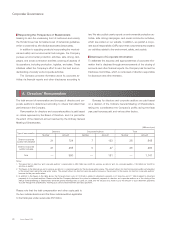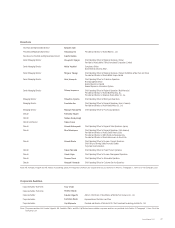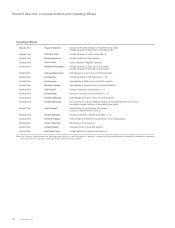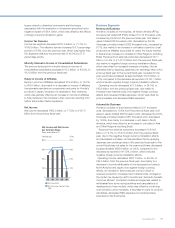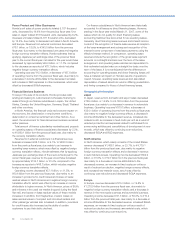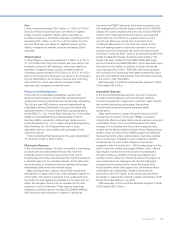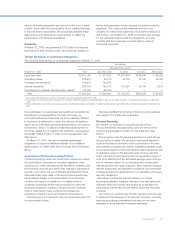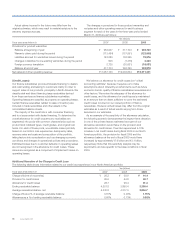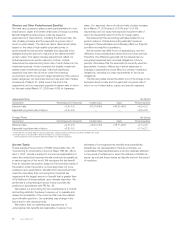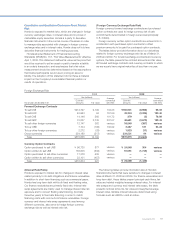Honda 2009 Annual Report Download - page 56
Download and view the complete annual report
Please find page 56 of the 2009 Honda annual report below. You can navigate through the pages in the report by either clicking on the pages listed below, or by using the keyword search tool below to find specific information within the annual report.
Power Product and Other Businesses
In the Power Product Business, we are seeking to develop
products that match customers’ lifestyles and needs while
strengthening our lineup of offerings that address
environmental issues.
Important developments in this segment in Japan during the
fi scal year included expanding the product lineup and sales
coverage of solar cell batteries manufactured by a Honda
subsidiary, which is engaged in the production and marketing of
these batteries. In view of the rising concern in Japan about
environmental issues, coverage was extended on a nationwide
basis to include not only units for use in households but also
thin-fi lm solar batteries for the public sector and industry. Also in
the power product operations in Japan, Honda introduced the
Yukios SB800, which is a compact and lightweight snow
removal device that clears snow without blowing it from one
place to another and can be used easily, even by beginners.
Also, in Japan, Honda introduced the Pianta FV200, a gas-
powered mini-tiller that uses the same butane gas canisters that
are already in wide use among households for powering
portable gas stoves. This mini-tiller is easy to use, even for
beginners, and is suited to making home gardening easier and
more fun.
R&D expenses in this segment in fi scal 2009 totaled to
¥57.2 billion.
Fundamental Research
In the area of fundamental research, Honda is pursuing steady
and varied research activities into technologies that may lead
to innovative applications.
One of Honda’s research initiatives is developmental work
on a Walking Assist Drive, which can provide support for
persons whose legs have become weak. Honda is conducting
this research jointly with medical institutions and has
announced a test model. Going forward, Honda will be
verifying the effectiveness of these devices in actual use.
In another research area, Honda has decided to build a new
research facility with the aim of commercializing manufacturing
technologies for bioethanol produced from cellulose materials,
including caulome, leaves, and other substances that are not
suited for consumption as food.
Additionally, Honda’s subsidiary, Honda Research Institute
Japan Co., Ltd., is conducting joint research on brain machine
interface (BMI) technology. These research activities are the
fi rst in the world to combine electroencephalography and
near-infrared spectroscopy technologies as well as newly
developed information extraction technology to devise
systems that will enable the control of robots by human
thought alone. Looking to the future, this technology will be
further developed for application to human-friendly products
by integrating it with intelligent technologies and/or robotic
technologies.
Expenses incurred in fundamental research are distributed
among Honda’s business segments.
Capital Expenditures
Capital expenditures in fi scal 2009 were applied to the
introduction of new models, upgrade, rationalize and renew
production facilities, as well as to expand and reinforce sales
and R&D facilities.
Total capital expenditures for the year amounted to
¥1,267.2 billion, down ¥226.0 billion from the previous year.
Also, total capital expenditures, excluding property on
operating leases, for the year amounted to ¥599.1 billion,
down ¥54.8 billion from the previous year. Spending by
business segment is shown below.
0
200
400
600
0
2
4
6
0908070605
R&D Expenses and R&D Expenses
as a Percentage of Net Sales
Years ended March 31
(%)Yen (billions)
R&D Expenses (left)
R&D Expenses as a Percentage
of Net Sales (right)
Fiscal years ended March 31,
2008 2009 Increase (Decrease)
Yen (millions)
Motorcycle Business ¥ 86,687 ¥ 90,401 ¥ 3,714
Automobile Business 544,922 490,760 (54,162)
Financial Services Business 839,888 669,178 (170,710)
Financial Services Business (Excluding Property on Operating Leases) 627 1,050 423
Power Product and Other Businesses 21,794 16,920 (4,874)
Total ¥1,493,291 ¥1,267,259 ¥(226,032)
Total (Excluding Property on Operating Leases) ¥ 654,030 ¥ 599,131 ¥ (54,899)
Note: Intangible assets are not included in the table above.
Annual Report 2009
54


